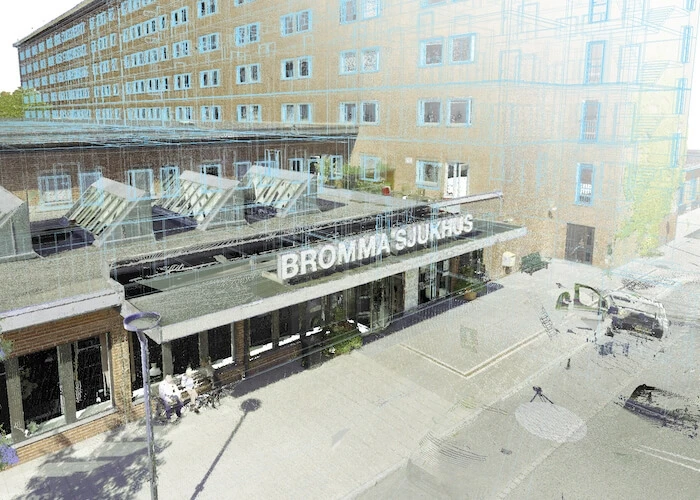& Construction

Integrated BIM tools, including Revit, AutoCAD, and Civil 3D
& Manufacturing

Professional CAD/CAM tools built on Inventor and AutoCAD
For many, recycling is second nature: People largely agree that throwing everything into one bin for burning or burying later is retrograde and wasteful. Extending that principle of separating from households to heavy industry has been harder to achieve. The ReCapture service from Sweden’s White Arkitekter promises to change that.
There have been impressive strides in recycling building materials such as steel, which is now the most recycled material on the planet. Today, there’s a steadily growing awareness that entire buildings can be reused, too. The hope is that by applying building information modeling (BIM) technology, the industry’s long trek to circularity can leap to full stride.
But construction finds itself in a paradox. While there’s talk everywhere about the benefits of the circular economy, architects and construction firms often struggle to turn green ambitions into practical outcomes.
Many construction projects seek to transform existing buildings into something more suited to modern work and living, particularly if the original structure holds heritage value. But the process of assessing a building’s reclamation potential can be manual and time-consuming.
Given a building’s size and complexity, capturing all of its components and materials and deciding which can be reused is a big job. Listing and measuring everything from beams to bolts is just the start. Each piece needs to be assessed to determine whether it’s reclaimable or if issues such as toxicity and carbon dioxide footprint mean disposal is the best option.
Even when this data is readily available, sharing it with everyone involved in a project presents its own challenges. The process involves multiple project stakeholders, a lot of documents, and many meetings. And then there’s the analog factor. Sure, measurements are often taken by a laser scanner, but pens and paper are still in everyday use. Later, it will all go into a spreadsheet, possibly with an accompanying photo—but not always.
Lack of standardization complicates things further. Measurement methods can vary from architect to engineer to consultant: How do they know if they’re comparing transversals to transversals when considering the angles of a doorway or facade individually, these may seem like micro issues. But taken together, they gum up project workflow and make construction’s contribution to a more circular economy harder to fulfill.
By conservative estimates, construction accounts for 30% of the extraction of the planet’s natural resources and generates 25% of the world’s solid waste. The UK Green Building Council’s annual Circular Economic Research Survey suggests that the planet is on course to triple material extraction during the next three decades. If the industry doesn’t change the way it operates, waste production will also triple by 2100.
Meanwhile, the price of building materials is going up. But recycling brings big financial benefits. In Europe alone, adopting circularity principles could lead to huge savings, business opportunities, and operational improvements worth more than $2 trillion per year by 2030.
White Arkitekter aims to cut through all of this complexity to help the industry reap both environmental and business benefits. The Swedish firm is one of Europe’s leading architecture practices and has a vision that by 2030 all of its projects will be climate neutral.
To get there, sustainability is a key focus. For its recently completed Selma Lagerlöf Center—a municipal government building and cultural center in Gothenburg, Sweden—the firm was able to incorporate reused furniture and materials in 92% of its interior design. This process saved approximately $1,079,205, a nearly 70% savings compared to the cost of using new materials.
The company’s new White ReCapture service offers a data-driven solution for capturing and cataloging all of the component parts of a built structure, from bricks and doors to ceilings, facades, and load-bearing walls. The service minimizes the headaches involved in assessing a building’s reuse potential.
Using laser scanning and BIM data-management tools, an inventory of building materials can be digitized to create a 3D model, which then can facilitate the development of a digital twin infused with construction and operational data. This information is then analyzed in software, with input from a professional who can judge and identify which parts are ripe for reuse.
The model contains all relevant information about materials and components, from weights and dimensions to costs, on-site location, and reclamation potential. Meanwhile, the digital twin brings together all the data created about the project’s design, construction, and performance and makes it available and accessible to architects, engineers, building contractors, consultants, and clients when they need it most to make informed decisions.
“If you’re showing a client something on a drawing, sometimes it’s tough to understand what it would look like in reality,” says Niklas Eriksson, environmental specialist and head of the ReCapture unit. “With this service, we create a common ground where we can show clients different options in the early stages of the project and make it easier for them to see how it could work.”
“In the past, you couldn’t really get that information over to the client without visiting the actual site and seeing it,” he continues. “Now, you can just go into the digital model, make the assessment, and then share it.”
That’s really a game changer for clients, Eriksson says, as it helps them make decisions about reuse at the start of the project, a crucial phase for securing buy-in on the best approach to sourcing material.
White Arkitekter’s new service relies on Autodesk BIM 360, Revit, and ReCap to make collaboration easier across the project lifecycle, even allowing for input from environmental consultants to become part of the model. This information allows clients to quickly and easily assess factors such as the toxicity of materials or their CO2 footprint.
The White ReCapture service is in use on several current projects, including the Bromma Sjukhus hospital in central Stockholm, a 35,000-square-meter transformation build that will renovate the 1971 structure to house new surgery facilities, a specialist geriatrics unit, housing for the elderly, and services such as shops and cafés.
“The ambition is to reuse the existing building and its components to as high an extent as possible,” says Björn Johansson, project architect on Bromma Sjukhus. “With this service, we’ve been able to make recycling an integral part of the design process. We’re currently capturing everything to be reused into a Revit model, where each element will be turned into new design components.”
For White Arkitekter’s Heinzelmann Areal project in Germany, the service was used to catalog everything in a 10,000-square-meter site comprising factory buildings from the late 1800s. The 3D model is being built to enable close collaboration among disciplines, from architecture to structural and mechanical engineers, heritage consultants, and fire-safety inspectors.
Construction is beginning to view buildings as depositories for materials, where the end of one structure’s lifespan allows a new structure to grow.
To realize that ambition, architects need practical tools that free them to visit sites with nothing more than a smartphone and quickly and easily survey reclaimable materials. BIM-based solutions such as ReCapture could prove to be a critical step forward in construction’s embrace of the circular economy.
The more information architects have at their fingertips from the start of a project, the more transparency they can offer clients about materials, costs, recyclability, and support for their clients’ own sustainability commitments. And then construction can move from “rip and replace” to sustaining a “circle of life” for the built environment.
Mark de Wolf is a freelance journalist and award-winning copywriter specializing in technology stories. Born in Toronto. Made in London. Based in Zürich. Reach him at markdewolf.com.
Executive insights
Executive insights
AECO









